Shabbat Books for Children (Page 2) |
If you wish to purchase any of these books, click on either the title or the book cover to be directed to Amazon.com. As a warning, I have put up pictures of the book covers to give you somewhat an idea of the style of each book (I know, I know. "Don't judge a book by its cover") so the pages may load slowly, depending on the speed of your internet connection.
For Family Siddurs, go to the Siddurim, Haggadahs, and Other Prayerbooks Page
For books containing all the Jewish holidays, go to
The
Holiday Collection Page
If this page came up without frames, Click here to see the complete "Books for Jewish Children" website
Other Pages of Interest:
Shabbat Picture Books
(Page 1)
(Page 2)
(Page 3)
(Page 4)
Holiday Picture Books:
Jewish Holiday Collections |
Shabbat Picture Books
(Page 1)
(Page 2)
(Page 3)
(Page 4) |
Rosh Hashanah & Yom Kippur Books |
Sukkot & Simchat Torah Books |
Hanukkah Books |
Tu B'Shevat & Lag B'Omer Books |
Purim Books |
Passover Books |
Shavout Books
Easy Reader and Picture Books:
Jewish Children's Books (General) |
Jewish Board Books |
Biblical Stories for Children |
Jewish Holiday Books |
Jewish Family Cookbooks |
Folktales and Talmudic Stories for Children |
Jewish Life Books (Mitzvot, Keeping Kosher, etc.) |
Jewish Life Cycle Books |
Family Haggadahs |
Children's Prayerbooks |
Introductory Hebrew Books |
Jewish History and Historical Fiction Picture Books |
Israel Books
Middle School and YA Books:
Bar Mitzvah Books |
Jewish Fiction |
Historical Fiction |
Torah Study |
Prayer and Jewish Life Books |
Jewish Holidays |
Jewish Biographies |
Jewish History Books |
Holocaust Books for Teens |
Israel Books
And More ...
Jewish Books for Children |
Bar Mitzvah Books |
Jewish Parenting Books |
Hanukkah Books |
Jewish Music for Children |
Jewish Videos |
Jewish Toys and Gifts |
Jewish Gift Baskets and Gourmet Food |
Jewish Jewelry |
Amazon.com Coupons, Promotions, and Sales
For books containing all the Jewish holidays, go to The Holiday Collection Page
If this page came up without frames, Click here to see the complete "Books for Jewish Children" website
Other Pages of Interest:
Shabbat Picture Books
(Page 1)
(Page 2)
(Page 3)
(Page 4)
Holiday Picture Books:
Jewish Holiday Collections |
Shabbat Picture Books
(Page 1)
(Page 2)
(Page 3)
(Page 4) |
Rosh Hashanah & Yom Kippur Books |
Sukkot & Simchat Torah Books |
Hanukkah Books |
Tu B'Shevat & Lag B'Omer Books |
Purim Books |
Passover Books |
Shavout Books
Easy Reader and Picture Books:
Jewish Children's Books (General) |
Jewish Board Books |
Biblical Stories for Children |
Jewish Holiday Books |
Jewish Family Cookbooks |
Folktales and Talmudic Stories for Children |
Jewish Life Books (Mitzvot, Keeping Kosher, etc.) |
Jewish Life Cycle Books |
Family Haggadahs |
Children's Prayerbooks |
Introductory Hebrew Books |
Jewish History and Historical Fiction Picture Books |
Israel Books
Middle School and YA Books:
Bar Mitzvah Books |
Jewish Fiction |
Historical Fiction |
Torah Study |
Prayer and Jewish Life Books |
Jewish Holidays |
Jewish Biographies |
Jewish History Books |
Holocaust Books for Teens |
Israel Books
And More ...
Jewish Books for Children |
Bar Mitzvah Books |
Jewish Parenting Books |
Hanukkah Books |
Jewish Music for Children |
Jewish Videos |
Jewish Toys and Gifts |
Jewish Gift Baskets and Gourmet Food |
Jewish Jewelry |
Amazon.com Coupons, Promotions, and Sales
Holiday Picture Books:
Jewish Holiday Collections | Shabbat Picture Books (Page 1) (Page 2) (Page 3) (Page 4) | Rosh Hashanah & Yom Kippur Books | Sukkot & Simchat Torah Books | Hanukkah Books | Tu B'Shevat & Lag B'Omer Books | Purim Books | Passover Books | Shavout Books
Easy Reader and Picture Books:
Jewish Children's Books (General) | Jewish Board Books | Biblical Stories for Children | Jewish Holiday Books | Jewish Family Cookbooks | Folktales and Talmudic Stories for Children | Jewish Life Books (Mitzvot, Keeping Kosher, etc.) | Jewish Life Cycle Books | Family Haggadahs | Children's Prayerbooks | Introductory Hebrew Books | Jewish History and Historical Fiction Picture Books | Israel Books
Middle School and YA Books:
Bar Mitzvah Books | Jewish Fiction | Historical Fiction | Torah Study | Prayer and Jewish Life Books | Jewish Holidays | Jewish Biographies | Jewish History Books | Holocaust Books for Teens | Israel Books
And More ...
Jewish Books for Children | Bar Mitzvah Books | Jewish Parenting Books | Hanukkah Books | Jewish Music for Children | Jewish Videos | Jewish Toys and Gifts | Jewish Gift Baskets and Gourmet Food | Jewish Jewelry | Amazon.com Coupons, Promotions, and Sales
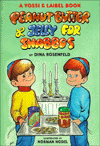 Peanut Butter and Jelly for Shabbos By Dina Rosenfeld |
The famous Jewish brothers Yossi and Laibel once again work together to do a good deed.
In this book, the brothers are anxiously awaiting the arrival from the hospital of
their new baby sister and parents. The boys are worried that their parents won't
arrive home in time to prepare for Shabbos, thus they take over and set a delightful
Shabbos table filled with their favorite foods. Peanut butter and jelly was their
choice for the main entree. The book exudes positive values. The brothers think and
plan and share the responsibility of helping their family celebrate the Shabbos.
Each brother uses his creativity to create the specialness that they feel is a part
of their family's Shabbos experience. The book has illustrations that show effectively
the strong emotions and temperament of young boys. Warm colors are used to enhance the
sense of the family's warmth.
Here is a rhymed book for 3 to 6 year olds with Yossi and Laibel preparing for Shabbat and the arrival of their mother home from the hospital with a newborn... Shows how young children deal with a situation that is important to them. |
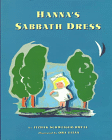 Hanna's Sabbath Dress By Izhak Schweiger-Dmi'el |
Delighted with the beautiful white dress Mother has made for her to wear on the Sabbath, Hanna goes
outside to show it off to her dog Zuzi and Edna the cow, warning them not to get too close or they'll
get her dress dirty. As she walks on, Hanna meets an old man carrying a heavy sack of charcoal on
his back and hurrying to get home before the Sabbath begins. Seeing how heavy his burden is, Hanna
offers to help by walking behind him and holding the heavy sack up a little. When she is done, Hanna
starts for home happily, until she looks down and realizes that she has charcoal stains all over her white
dress. Beginning to cry inconsolably, she hears a whisper from the moon asking why she is crying and
whether she regrets helping the old man. Hanna answers that she's not at all sorry but she is still heartbroken
about spoiling the dress her mother made for her. Whispering, "All will be well," the moon follows Hanna
home, flooding her with moonbeams until her dress glows like silver and every stain is gone. Originally
published in Hebrew in 1937, the simple story is a perfect example of the moral tale in which a child's
act of kindness is rewarded in a mysterious and magical way. Hanna's joy in her new white dress is made
palpable by Eitan in four small poses in which Hanna turns this way and that to admire herself. In many
scenes, Hanna is little more than a white silhouette against a simple but vividly colored background, yet
the stylized illustrations create an endearing portrait of the little girl and her adventures.
|
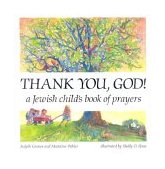 Thank You, G-d! : A Jewish Child's Book of Prayers By Judyth Groner and Madeline Wikler, |
A first prayerbook for young children, with 21 traditional prayers in simple Hebrew, transliteration and English. Blessings for a new day, bounty of our food, Sabbath, and holiday rituals.
Haas' finely worked watercolors evince a sense of serenity, as though echoing one of prayer's purposes. The morning sun highlights the silhouettes of two awakening children; parents' heads bend in a sheltering posture over the children with whom they are welcoming Shabbat; the havdalah candle's broad flame reflects from the faces of youngsters transfixed by its flare. Children catching fireflies and decorating a succah are among the other tenderly painted images that frame the blessings and prayers, which are printed in Hebrew block letters, with a Roman alphabet transliteration and an English translation below. In addition, brief, explanatory notes often place the prayers within a relevant context for youngsters. This thoughtfully prepared book not only teaches the blessings that herald the holidays and that welcome and close each day and each meal, but also includes parts of the Mi Sheberach and the Kaddish, prayers to turn to as needed when a loved one is ill or has died or when praying for peace. There is surprisingly little duplication between this and Edwards' "Blessed Are You: Traditional Everyday Hebrew Prayers". |
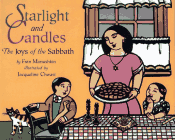 Starlight and Candles : The Joys of the Sabbath By Fran Manushkin |
This affectionate look at the traditions of the Sabbath
follows a family through the hectic preparations to the peaceful
time of the Sabbath itself--a time for dinner with the family,
stories from grandparents, attendance at the Synagogue.
Three stars in the sky signal the end of the Sabbath, but the
children know there will be another one--forever and ever.
A Jewish family prepare to observe Shabbat, the day of rest, which begins at sundown every Friday. Information about the holiday and glimpses of the past are woven easily into the book. Chwast's crisp illustrations use strong black lines and warm colors to heighten the joy. While somewhat idealized, the book conveys the spirit and purpose of this weekly celebration |
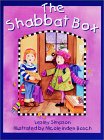 The Shabbat Box By Lesley Simpson |
It was finally Ira's turn to take home the Shabbat Box -- a velvet-covered shoe box with
candlesticks, a kiddush cup, and fresh raisin challah rolls. He had waited 14 weeks (98 sleeps!)
which seemed like forever. But a bad snowstorm blew open his book bag, and the box was lost.
What would Ira do? A warm introduction to Shabbat in the life of a preschooler.
Ira can't wait until it is his turn to bring home his class's "Shabbat Box," but when it finally comes, he loses the box in a snowstorm. Extremely upset, he takes his mother's words to heart when she asks, "How do you think we can solve this?" and he makes a new one to replace the original. Everyone at school loves it, but it turns out that his teacher found the lost box in the snow, so now there are two. The cartoon illustrations are done in a rather cloying greeting-card style and most people have round, red, pursed lips. The concept of Shabbat and the box's importance are never really explained, which limits the book's accessibility to people familiar with the holiday. Ira's dilemma and his solution are positive plot elements, if somewhat predictable, and the simple text, which captures the child's voice and concerns, will be accessible to young listeners. |
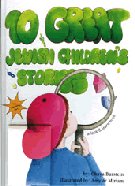 10 Great Jewish Children's Stories By Chaya Burnstein |
Double-spread Shabbat and Holiday stories with simple "Do You Know That..." facts at the end of each story. The illustrations have hidden holiday items scattered throughout the pictures. Children use the magnifying glass attached to the front of the shrink-wrapped cover to find the hidden items.
This is the only Jewish Holiday title featuring an attached magnifying glass that helps the children recognize and discover Jewish Holiday objects. |
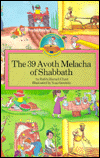 39 Av Melachoth of Shabbath By Baruch Chait |
Illustrated guide to the forbidden Shabbat activities. Simplifies the complex laws in a way that is easy for children to understand. |
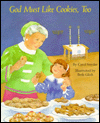 God Must Like Cookies, Too |
In this tender story of a little girl and her grandmother enjoying Shabbat together, award-winning author
Carol Snyder has created a warm, modern story for very young Jewish children. We join the two as they
attend a sculpture class, go ice skating, then prepare for the Sabbath and go to synagogue together.
It is all told in a charming blend of humor and sensitivity. It is a wonderful introduction to Friday night
services in a Reform temple. It celebrates the special joys of Shabbat when shared between generations.
|
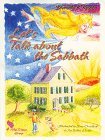 Let's Talk About the Sabbath By Dorothy K. Kripke |
How do you teach Shabbat to children so that it really matters in their lives? Let's Talk about the Sabbath, a new book by veteran children's writer Dorothy Kripke, helps parents and teachers do just that-by capturing a bit of Shabbat's magic within its pages.
For over 45 years Kripke has been teaching children and adults about the beauty of Judaism, its celebrations and lifecycle events. Best known for her Let's Talk About... series for young children, Kripke's signature style draws readers in with simple yet meaningful descriptions of Jewish life. Let's Talk about the Sabbath delves into one of Judaism's most beautiful and central concepts, providing young people with their own guide to the Sabbath. Beautifully written in poetry and prose, Kripke enchants readers with all the aspects of Shabbat, including candles and wine, Sabbath angels, study and prayer, and the beautiful Havdalah ceremony that ends the day. Kripke's well-rounded work also includes a description of how Shabbat has been observed throughout history, as well as explanations of how other Jewish lifecycle events such as brit milah and bar/bat mitzvah connect with Shabbat to create the fabric of Jewish life. The final chapter confronts the challenges of observing Shabbat in the modern world, noting that, although some families may not be able to observe Shabbat fully, there are still unique aspects of Shabbat that they can bring into their home. As in her previous books, Kripke addresses her reader intimately, as a close friend. Let's Talk about the Sabbath opens with a letter to the reader, using a parable to gently set the tone for a magical journey into the world of Shabbat. Children will be drawn in by the letter's first lines, "Have you ever found secret treasure? You can! Where? In 'make-believe' stories! Not gold, or silver, or jewels, but something even more precious-ideas!" Each chapter also begins with a rhymed verse about different aspects of the Sabbath, such as prayer, study and rest. With Kripke's graceful text and rich, original artwork by artists Stacy Crossland and Joy Nelkin Weider, Let's Talk about the Sabbath will be a truly valuable addition to any family's Judaica collection. Nothing else-except Shabbat itself-quite captures the cadences of this special day. |
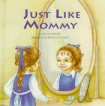 Just Like Mommy By Baila Olidort |
Shoshana's almost three, and a special surprise awaits her on her birthday --
a beautiful silver candlestick because now she is big enough to light her own
Shabbos candle. Rhythm and repetition help form the suspense in this charming
picture book, just right for young children.
|
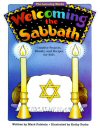 Welcoming the Sabbath: Creative Projects, Rituals, and Recipes for Kids By Mark Falstein |
Includes:
|
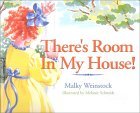
There's Room in My House! By Malky Weinstock |
Young Sarah comes up with all the reasons in her little world, why having a Shabbos guest seems impossible to her ...until her cousin Rachel shows up unexpectedly at her door . One guest brings another, and just as unexpectedly, Sarah's perception changes..as she discovers the joys of having guests, and she realizes that ....There's Room in My House!
There's Room In My House! is a charming story for youngsters, passing along the traditional concept of Hachnosas Orchim, or hospitality, so central to every Jewish home. Perhaps, in a world of selfishness, There's Room In My House! conveys the idea that sharing with others, provides true happiness and self-satisfaction. |
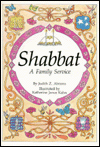 Shabbat: A Family Service By Judith Z. Abrams |
Simple poetry and full color pictures bring to life the structure and concepts of the Shabbat service. |
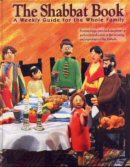 The Shabbat Book - A Weekly Giude For The Whole Family |
This beautifully illustrated book can be read by children alone or in a family setting. With a colorful page for each week of the Jewish calendar, it is designed to integrate the weekly Torah portion with the ideas, traditions and customs of the Sabbath. Conceived and published by the producers of the Animated Haggadah, The Shabbat Book will appeal to every Jewish child - and parent.
Each week of the Jewish calendar gets its own page, illustrated with claymation figures from the Shalom Shabbat video. Contains Torah portions, prayers, customs, thoughts and tales. |